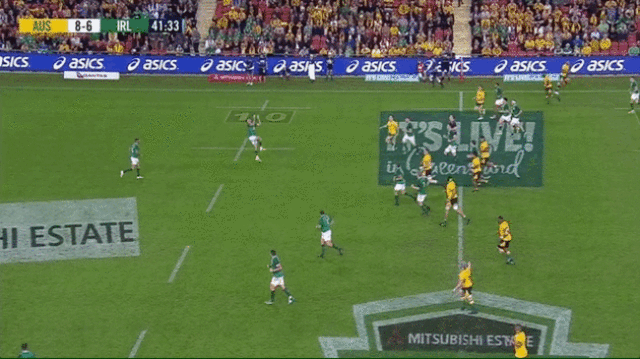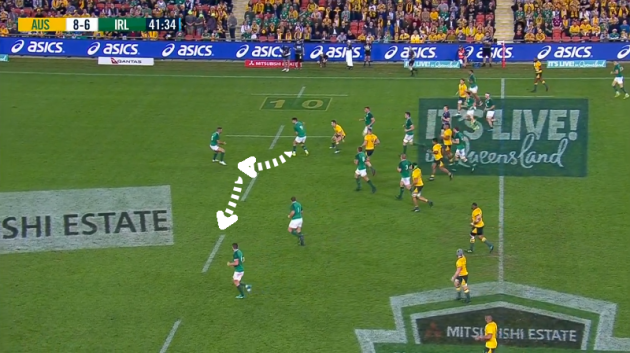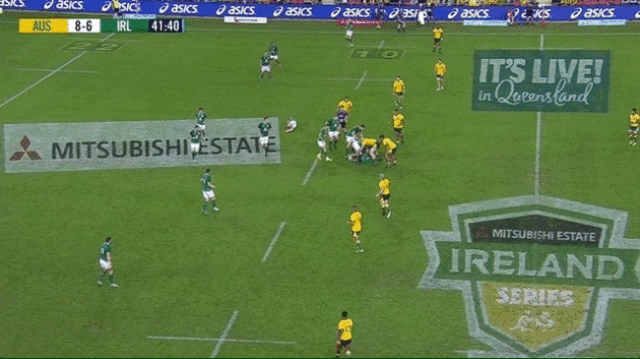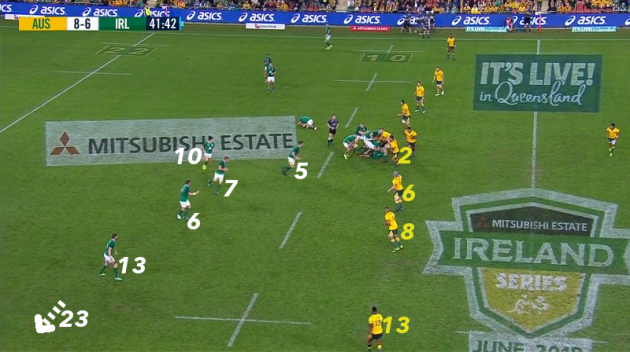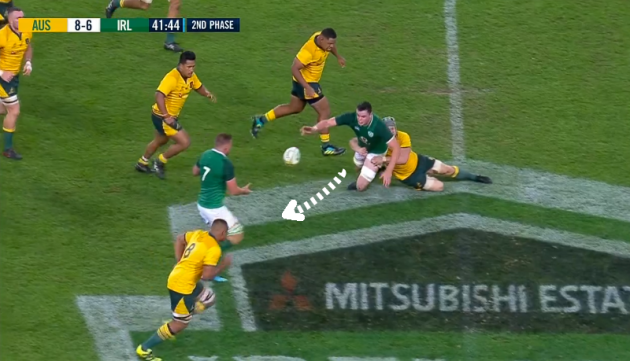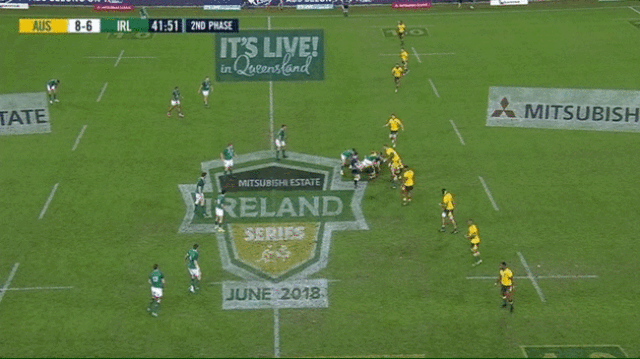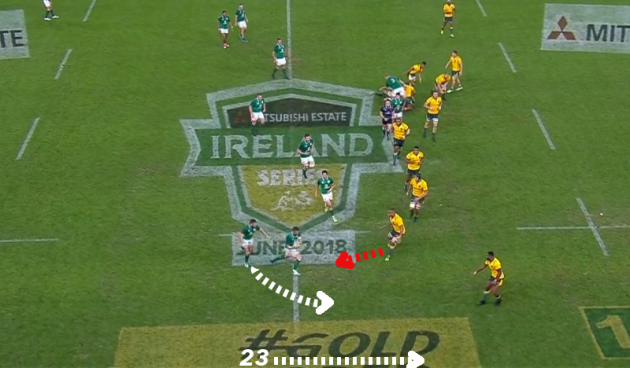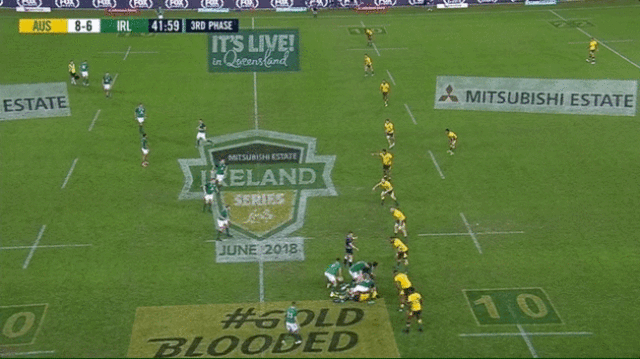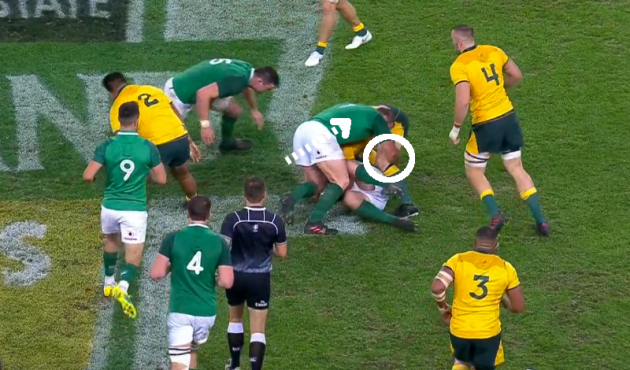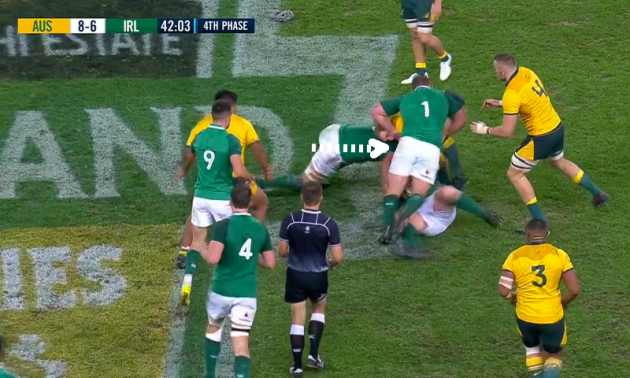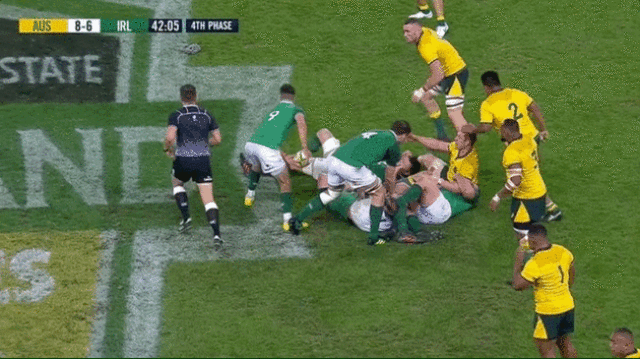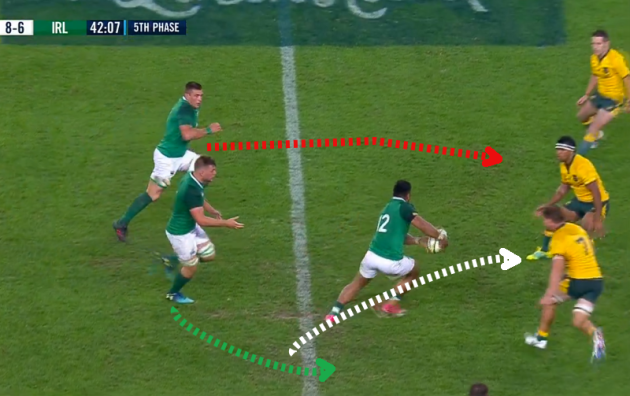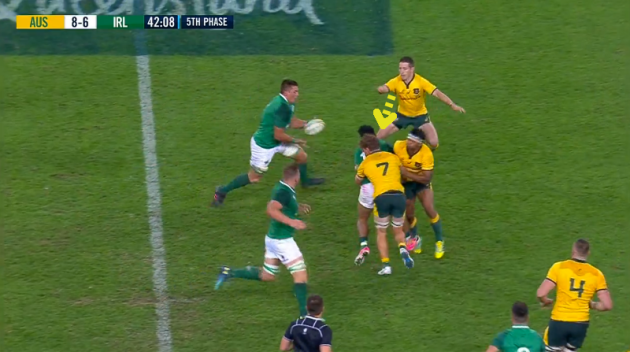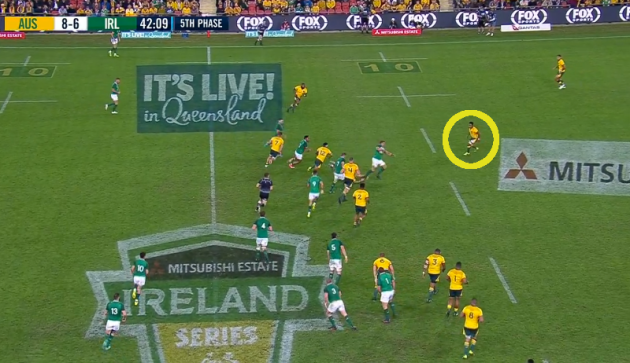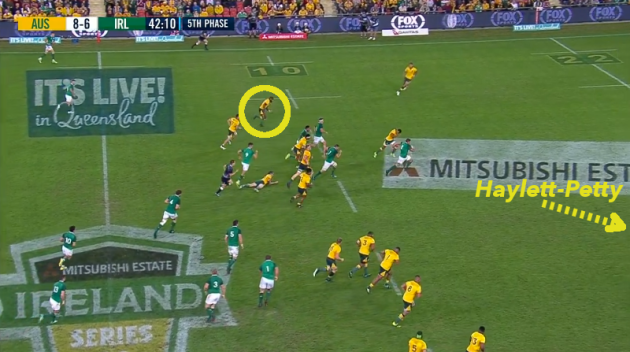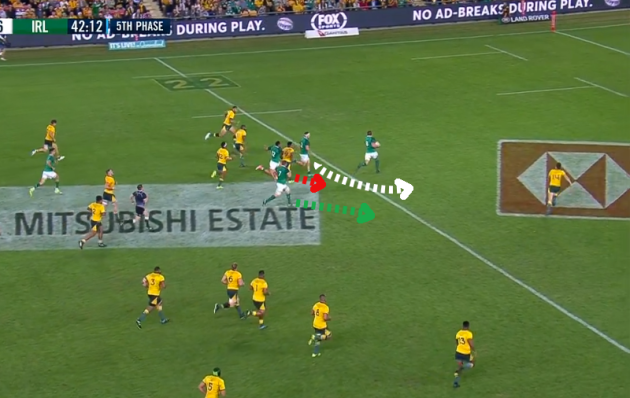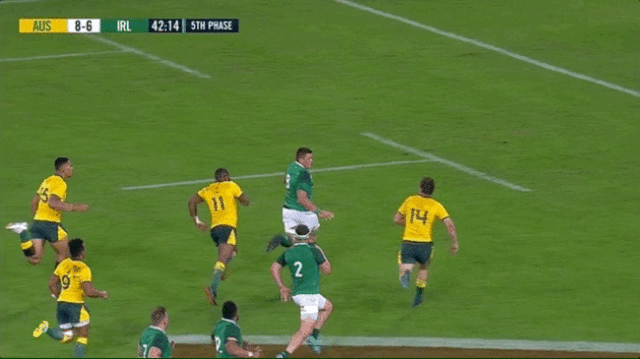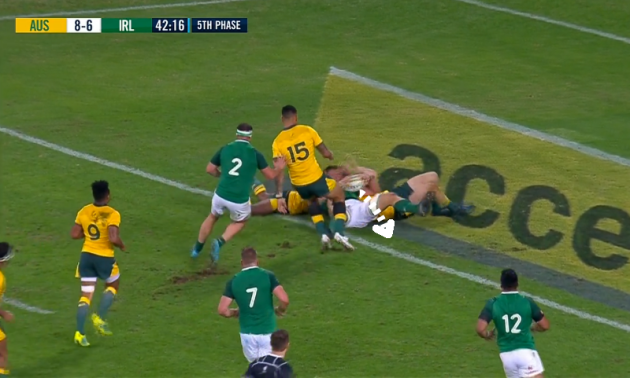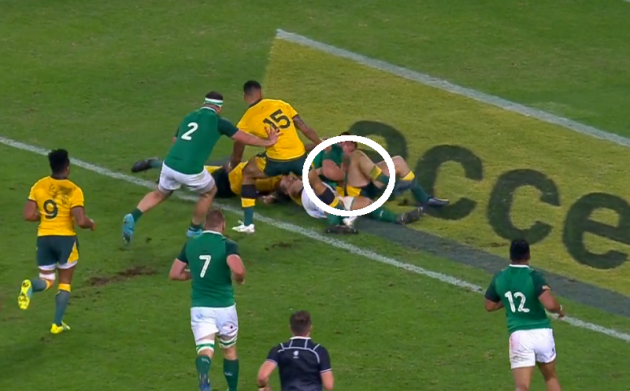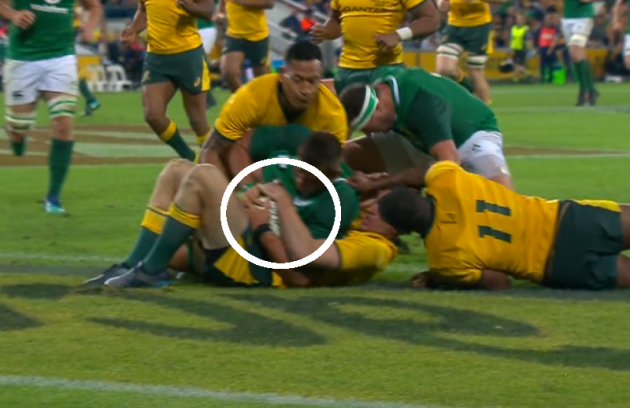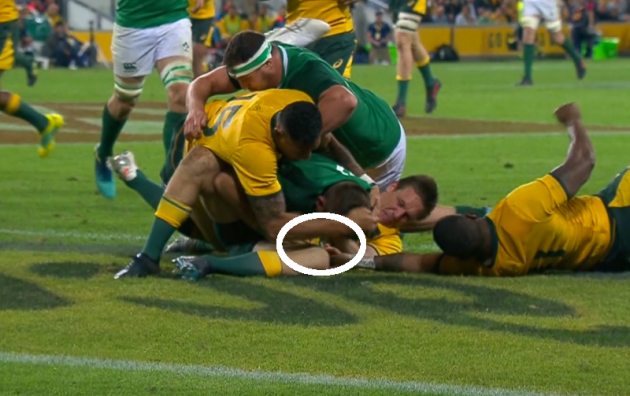JOE SCHMIDT PINPOINTED it as being one of the most decisive moments of the first Test, while several Irish players wondered what might have been had CJ Stander been awarded a try in the 43rd minute in Brisbane last weekend.
Ireland would have gone 13-8 ahead after the probable conversion and moved into a strong position from which to potentially see out the game.
Firstly, it’s worth examining the positive Irish play that built the opportunity.
Conor Murray fields an Australian kick and we see something relatively rare from Ireland – two passes on a kick return.
Click here if you cannot view the clip above
The two passes from Murray to Rob Kearney and Kearney to Jack McGrath are simple, but that movement of the ball allows McGrath to make the first carry in more space than would have been the case for Murray or Kearney.
It’s encouraging from Ireland and it sets them up for a strong second phase, after Stander, Iain Henderson and John Ryan resource the ruck.
James Ryan had another superb game for Ireland, making 15 tackles and carrying 16 times for an average gain of 2.7 metres per carry, an impressive figure.
Ryan is obviously an explosive athlete but another reason he is so effective at carrying the ball is the timing of his runs, with a fine example below.
Click here if you cannot view the clip above
Before we dig into Ryan’s carry, it’s worth noting that this is possibly a missed chance for Ireland to attack out wide.
As we can see below, the Wallabies have four defenders on that side of the ruck, whereas Ireland have six attackers.
It may well be a moment where Joey Carbery [10] reflects that he could have demanded the ball from Conor Murray with a pass behind Ryan [5], although we don’t know if he was getting a call from the outside to flash the ball wide.
Either way, the Wallabies defence is stretched and Ryan runs an excellent line off Murray into space as David Pocock [6] worries about Ireland’s numbers out wide and leaves a gap on his inside.
As is consistently the case, Ryan arrives at the perfect time to take the pass and break the gainline.
Coming around the corner from left to right, Ryan delays his run intelligently, staying slightly hidden in behind the ruck and ensuring that by the time Murray picks the ball and looks to pass, Ryan is accelerating up to full speed close to the gainline.
It seems like a very obvious thing to point out, but it is something that other ball carriers don’t do all the time.
Often, we see carriers arriving a little early in their eagerness to work hard into position, but Ryan is clever enough to time his arrival and that allows him to punch over the gainline - defenders having less time to react to his running line at a soft shoulder or sliver of space.
Ryan gets beyond Pocock’s tackle as the flanker turns in recover – he can’t get a shoulder on – and offloads skillfully to Jordi Murphy, who has run a positive support line.
James Ryan, arguably entering from the side, clears out the jackaling Brandon Paenga-Amosa at the subsequent ruck, while John Ryan stands over the ball as the guard.
There’s another hint of opportunity on the outside edge on the third phase, as we can see below.
Click here if you cannot view the clip above
Carbery moves the ball to Peter O’Mahony and Henshaw, having tucked to the inside of the Ireland captain, runs a clever line back to his outside.
With Caleb Timu worried about O’Mahony carrying the ball and marking up on him [indicated by red below], there is a brief window for the Ireland flanker to pop the ball to Henshaw bursting to his outside.
With Samu Kerevi isolated on the edge of the Wallabies defence and Jordan Larmour [23] holding width just out of shot, there may have been a linebreak on for Ireland at this point, although Timu could well have drifted off O’Mahony and tackled Henshaw.
Instead, O’Mahony – who did pass sharply five times in this game, as well as showing off his grubber-kicking skill – opts to dummy the pass to Henshaw and carries, with Henshaw, Carbery and Henderson resourcing the ruck.
Ireland move infield again and John Ryan makes a carry directly into Pocock.
Click here if you cannot view the clip above
As we know, Ireland had real problems with Pocock at the breakdown but they nail him in this instance as the exceptional Wallabies back row stays on his feet after the tackle and looks to clamp onto the ball.
Jack McGrath is the first arrival for Ireland and he does a superb job with his ‘barrel,’ hammering his left shoulder into Pocock with real aggression and firmly wrapping his right arm around Pocock’s left leg to remove one of the pillars that keeps him on his feet.
James Ryan, having initially been cleverly impeded on his way to the ruck by Paenga-Amosa, hammers in as the second arrival and targets Pocock’s arms, i.e. his connection to the ball.
Having had his hands on the ball, Pocock appeals for the penalty but Ireland’s vicious ruck work on him is successful and they are ready to strike on the next phase.
Ireland did seem to lack a creative decision-making touch in their backline at times in the defeat last weekend, but Bundee Aki delivers exactly that here.
Click here if you cannot view the clip above
Aki is at first receiver for Ireland and he runs a clever line arcing outwards initially but then subtly straightens at Kurtley Beale’s inside shoulder, as indicated in white below.
The threat of Aki carrying the ball lures Beale into sitting down on his heels, even though Michael Hooper [7] has worked across to cover Aki.
Jordi Murphy runs a switch underneath Aki [green], hoping to draw off Hooper, who instead sticks on Aki.
With Beale sitting down on Aki, there is suddenly space on the Wallabies inside centre’s outside shoulder and Stander runs a superb line to take advantage of that, as indicated in red above.
Bernard Foley is the next defender outside Beale and expects the centre to drift off Aki and deal with Stander, given that Hooper has Aki covered.
But with Aki threatening his inside shoulder, Beale commits and Stander intelligently changes his running line at the last split-second, angling back in towards Aki’s pass and outside Beale.
Foley has to turn in on Stander late [yellow above] and as a result, can’t get a shoulder into the tackle, leaving the accelerating Stander to burst through his despairing arms and clean through the defensive line.
Defensive sweeper Will Genia, circled below, has advanced past the ball in behind the defensive line and is slow to react to Stander’s break.
It means Stander is suddenly into open country as he gets up to full sprinting stride, the ball tucked into his right arm after he has used his left to help him beat Foley’s tackle attempt.
Click here if you cannot view the clip above
Before examining Stander’s actions in behind the line, let’s underline the quality of the scramble defence from Wallabies wings Marika Koroibete and Dane Haylett-Petty here, their work-rate to save what looked like being a try truly standing out.
We can see Koroibete circled in yellow below, while Haylett-Petty is off screen sprinting across from the left-hand side of the Wallabies’ backfield.
Obviously, their pace helps greatly here but the work-rate is sensational, with both players covering major ground at high speed and producing a try-saving tackle on Stander.
What of the Ireland number eight’s decision-making?
There have been suggestions that he should have straightened and drew in Haylett-Petty before hitting Rob Herring [circled in white below] on his left.
But that option would have almost certainly resulted in a tackle on Herring by the hard-working Koroibete, as indicated in yellow above.
Perhaps more realistic would have been a pass to Herring as he cuts underneath Stander [white below], who arcs out to his left in an attempt to get away from Haylett-Petty.
With Aki [red] and Murphy [green] also in support, a switch pass from Stander to Herring in this freeze-framed split second above might well have resulted in a score for Ireland, Herring having two further players to support him even if Haylett-Patty can readjust and tackle the hooker.
But it is infinitely easier to point that out with the benefit of freeze frames and multiple replays, rather than when moving at top speed in a noisy, high-pressure Test match.
What was going through Stander’s head in this moment?
“I see Rob but I don’t know what’s going on behind me so I don’t know if there’s another guy [one of the Wallabies] who can intercept the pass or maybe hit him and I go down and he goes down,” explains Stander.
“If I look back and I know Jordi and Bundee were there, it’s tough, but I didn’t know that at the time.
“So in my head, the momentum will carry me over [the tryline] but if I go down [before the tryline] Rob’s there to clean up with the ball after.”
It’s a fair explanation from Stander – he wasn’t certain which Wallabies players were in behind him, potentially waiting to pick off the ball or hammer Herring with an immediate ball-and-ball tackle.
Stander backed himself instead, switching the ball into his left hand and looking for the fend on Haylett-Petty. Stander’s main regret is the manner in which he attempted to finish once he was over the tryline.
Click here if you cannot view the clip above
“If I look back on it, if I’d have just sat and put the ball down between my legs [I'd have scored], but that’s hindsight,” says Stander.
“It’s so quick on the pitch, you just want to get the ball on the floor.”
Indeed, looking back with our freeze frames, there was a window for Stander to sit up and possibly dot the ball down between his legs, although his momentum lends itself to rolling forward and having a go at finding grass.
Haylett-Petty does superbly on the ground, first lifting his right leg up to trap the ball…
… and then, as Stander looks to bring the ball over him, Haylett-Petty wraps it with his left arm.
The ball does potentially nick the ground as Stander looks to force it down through Haylett-Petty’s arm and Stander’s own left arm, which is initially underneath the ball too.
“I reckon there’s a bit of grass there I surely grounded the ball on,” says Stander. “I’d say that was a 50-50.”
Referee Marius van der Westhuizen, positioned on the far side of this pile of bodies, has no view at all of a possible grounding, while assistant referee Paul Williams is late arriving and can’t make a clear decision as a result.
Van der Westhuizen halts play and says to Williams, “I don’t have a clear grounding – [should I ask the TMO] try, no try?”
Williams responds, “It looks held up to me, but I’d definitely have a check.”
Van der Westhuizen calls in television match official Ben Skeen and says, “Ben – try, no try, please.”
Joe Schmidt was frustrated that van der Westhuizen didn’t ask Skeen the “other question,” that being, “is there any reason not to award the try?” but it’s clear from the replays and the match officials’ dialogue that neither van der Westhuizen or Williams had clear reason to believe it was a try.
In fact, Williams’ view was that it looked to have been held up, so it does seem fair to ask the TMO for a “try or no try” decision.
Just over a minute later, Skeen returns a verdict: “Marius, the footage is inconclusive, so the outcome is an attacking scrum.”
“Yeah, ok,” replies van der Westhuizen and signals the Ireland scrum.
Damagingly for Ireland, they fail to take their five-metre chance from that scrum, going through 19 phases against the firm Wallabies defence before Pocock pounces for a turnover penalty.
Stander has swiftly moved on and won’t be losing sleep over the non-try. He says that “one thing I’ve learned from my dad” is that if you dwell on the near-misses, “it’s going to drag you down.”
“Hopefully, if I get in that same position then I’ll know what I’m going to do.”
The42 is on Instagram! Tap the button below on your phone to follow us!
